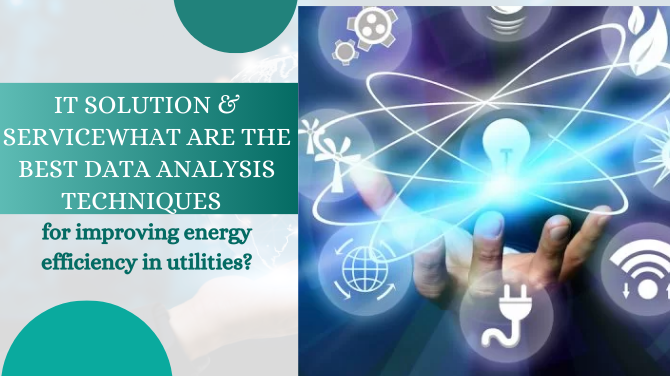What are the best data analysis techniques for improving energy efficiency in utilities?

March 26, 2024
 137
137
The energy sector is constantly evolving, with a growing focus on sustainability and cost reduction. Utilities are under pressure to deliver reliable power while minimizing environmental impact and keeping consumer bills manageable. Here's where data analysis steps in as a powerful weapon in the fight for energy efficiency.
By leveraging data from various sources, utilities can gain a deeper understanding of their operations and identify areas for improvement. This blog dives into the best data analysis techniques for achieving significant energy efficiency gains:
1. Data Collection and Integration: The Foundation
The journey begins with gathering data from a multitude of sources, including:
- Smart meters: These provide real-time information on customer energy consumption patterns.
- Sensors: Deployed across the grid, they monitor equipment performance and identify potential problems.
- Weather forecasts: Understanding weather patterns helps predict future energy demand and optimize generation.
- Customer feedback: Surveys and billing data can reveal energy usage habits and areas for targeted efficiency programs.
- Operational records: Historical data on maintenance, repairs, and grid losses helps identify inefficiencies.
Data warehouses, data lakes, or cloud platforms are instrumental in storing, managing, and integrating this vast amount of structured and unstructured data.
2. Data Visualization and Exploration: Making Sense of the Numbers
Once the data is collected, transforming it into clear visuals is crucial. Techniques like:
- Charts and graphs: These reveal trends in energy consumption, peak demand periods, and equipment performance.
- Heat maps: They visually represent energy usage across geographical areas, pinpointing high-consumption zones.
- Interactive dashboards: These allow real-time monitoring of key metrics, enabling quick decision-making.
Data exploration involves techniques like:
- Data mining: Unearthing hidden patterns and correlations within the data.
- Statistical analysis: Identifying significant relationships between variables, like weather and energy demand.
By visualizing and exploring the data, utilities can identify areas of energy waste and prioritize efficiency measures.
3. Data Analysis and Modeling: Predicting and Optimizing
This stage involves using sophisticated techniques to gain deeper insights:
- Machine learning: Algorithms can predict future energy demand, optimize dispatch from renewable sources, and identify potential equipment failures before they occur.
- Regression analysis: Helps quantify the impact of different factors like weather and customer behavior on energy consumption.
- Time series analysis: Predicts future energy usage based on historical data and seasonal trends.
These techniques empower utilities to:
- Forecast demand: Proactively prepare for peak periods and avoid costly energy purchases.
- Optimize generation: Integrate renewable energy sources more effectively and reduce reliance on traditional power plants.
- Target efficiency programs: Identify customer segments with the highest energy-saving potential.
4. Data-Driven Decision Making and Action: Putting Insights into Practice
The ultimate goal is to translate data insights into actionable steps. This involves:
- Cost-benefit analysis: Evaluate the financial viability of different energy efficiency initiatives.
- Developing targeted programs: Design programs like smart thermostat rebates or time-of-day pricing to incentivize customer participation.
- Optimizing grid operations: Reduce line losses and improve overall grid efficiency based on data-driven insights.
By taking decisive action based on data analysis, utilities can achieve significant and measurable energy savings.
Conclusion
Data analysis is no longer a luxury, but a necessity for utilities in today's competitive landscape. By harnessing the power of data, utilities can unlock a future of energy efficiency, reduced costs, and a more sustainable energy ecosystem.